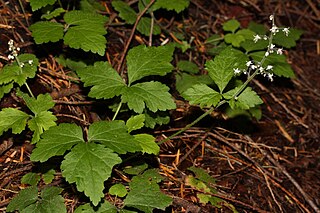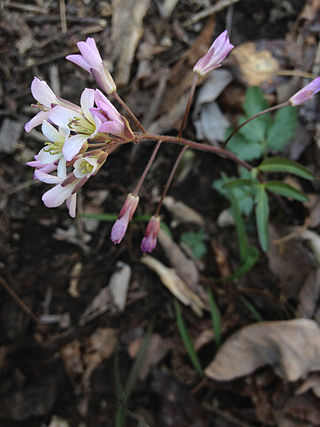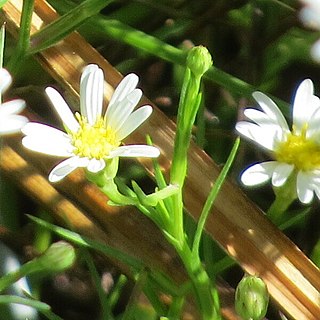
Trillium is a genus of about fifty flowering plant species in the family Melanthiaceae. Trillium species are native to temperate regions of North America and Asia, with the greatest diversity of species found in the southern Appalachian Mountains in the southeastern United States.

Eriophorum is a genus of flowering plants in the family Cyperaceae, the sedge family. They are found in the cool temperate, alpine, and Arctic regions of the Northern Hemisphere, primarily in the middle latitudes of North America, Europe, and Asia.

Tiarella, the foamflowers, is a genus of flowering plants in the family Saxifragaceae. The generic name Tiarella means "little turban", which suggests the shape of the seed capsules. Worldwide there are seven species, one each in eastern Asia and western North America, plus five species in eastern North America. As of October 2022, the taxonomy of Tiarella in eastern North America is in flux.

Trillium rugelii is a species of flowering plant in the family Melanthiaceae. It is endemic to the southeastern United States. Its white flower is typically found nodding beneath the leaves, hence it is known as the southern nodding trillium. The specific epithet rugelii honors Ferdinand Rugel, a botanist and plant collector who collected plant specimens throughout the southeastern U.S. during the period 1840–1848. Although the species is apparently secure across its range, statewide it is vulnerable at best.

Trillium vaseyi is a species of flowering plant in the family Melanthiaceae. It is a spring-flowering perennial plant found only in the southeastern United States. The specific epithet vaseyi honors the American plant collector George Richard Vasey, not to be confused with his father George S. Vasey. The species is commonly called Vasey's Trillium. It is also known as the sweet wakerobin, sweet trillium, or sweet beth.

Tiarella trifoliata, the three-leaf foamflower, is a species of flowering plant in the family Saxifragaceae. The specific name trifoliata means "having three leaflets", a characteristic of two of the three recognized varieties. Also known as the laceflower or sugar-scoop, the species is found in shaded, moist woods in western North America.

Rugelia nudicaulis, the sole species of the genus Rugelia, blooms in summer. It is a wildflower endemic to higher elevations in the Great Smoky Mountains. It is a rare species in Tennessee. Genetic diversity in this plant, assessed using allozymes, is so low that the species may not survive changing environmental conditions. Both the scientific name and the common names honor Ferdinand Rugel, a botanist and plant collector who collected plant specimens throughout the southeastern United States during the period 1840–1848.

George S. Vasey was an English-born American physician and botanist. He practiced medicine in Illinois for nearly two decades. He was appointed Chief Botanist at the United States Department of Agriculture in 1872, a position he held for the remainder of his life. His greatest achievement was the building up of the United States National Herbarium.
Eryngium vaseyi is a species of flowering plant in the family Apiaceae. It is endemic to California. The specific epithet vaseyi honors the American plant collector George Richard Vasey who made extensive collections in the region in 1880 and 1881. The species is commonly called Vasey's coyote-thistle.

Vaseyochloa is a monotypic genus in the grass family Poaceae. Its sole species, the flowering plant Vaseyochloa multinervosa, is endemic to Texas. It is commonly known as Texasgrass.

Salvia vaseyi, the scallop-leaf sage, bristle sage or wand sage, is a perennial native to the western Colorado Desert. The specific epithet vaseyi honors the American plant collector George Richard Vasey, not to be confused with his father George S. Vasey.

Rhododendron vaseyi, the pinkshell azalea, is a species of flowering plant in the heath family Ericaceae. It is endemic to the Appalachian highlands of North Carolina. The specific epithet vaseyi honors the American plant collector George Richard Vasey and his father Dr. George Vasey, Chief Botanist at the United States Department of Agriculture from 1872 to 1893. The species is sometimes referred to as the Vasey Rhododendron.

Cardamine angustata is a perennial forb native to the eastern United States, that produces white to pink or purple flowers in early spring.
Hymenoxys vaseyi is a species of flowering plant in the daisy family Asteraceae. It is native to the Southwestern United States. The specific epithet vaseyi honors the American plant collector George Richard Vasey who made extensive collections in the region in 1880 and 1881. The species is commonly called Vasey's rubberweed.

Quercus vaseyana is a species of tree in the beech family Fagaceae. It is native to northern Mexico and the U.S. state of Texas. The specific epithet vaseyana honors the American botanist George S. Vasey. The species is commonly called the Vasey oak.

Symphyotrichum potosinum is a species of flowering plant in the family Asteraceae native to Mexico and the U.S. state of Arizona. Commonly known as Santa Rita Mountain aster, it is a perennial, herbaceous plant that may reach heights of 15 to 45 centimeters.

Eriophorum virginicum, the tawny cottongrass, is a species of flowering plant in the sedge family Cyperaceae. It is native to eastern North America but was introduced into both British Columbia and Washington in western North America. It is most common in eastern Canada, New England, and the Great Lakes region. It is the only species of Eriophorum in North America that occurs in the southeastern United States, where it is uncommon. The common name refers to the tawny color of its fruiting head. Despite the name, it is a sedge, not a grass, and it is sometimes called tawny cottonsedge to emphasize this fact.
George Richard Vasey (1853–1921) was an American plant collector who collected in at least eight U.S. states including California, North Carolina, and Washington. He was the son of Dr. George S. Vasey, a physician and botanist. The botanical activities of father and son overlapped in time, so the two men are often confused.
Juncus vaseyi is a species of flowering plant in the rush family Juncaceae. It is native to North America. The specific epithet vaseyi honors the American botanist George S. Vasey. The species is commonly called Vasey's rush.
Echinopepon rosei is a species of flowering plant in the gourd family Cucurbitaceae.
















